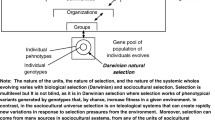Abstract
This essay extends Levins’ 1966 analysis of model building in ecology and evolutionary biology. A model, as the product of modeling, might be valued according to its correspondence to reality. Yet Levins’ emphasis on provisionality and change redirects attention to the processes of modeling, through which scientists select and generate their problems, define their categories, collect their data, compare competing models, and present their findings. I identify several points where decisions are required that are not determined by nature. This invites examination of the social considerations modelers are reacting to at the “sites of sociality”. Modelers must weave “socio-ecological webs” so that the models can be seen to represent their subject matter at the same time as the modelers secure the support of colleagues, collaborators and institutions, and enjoin others to act upon their conclusions. Not only do theory justification and theory generation merge, but the joint project becomes simultaneously philosophical and sociological.
Similar content being viewed by others
References
Austin, M.P.: 1980, ‘Searching for a Model for Use in Vegetation Analysis’, Vegetatio 42, 11–21.
Caswell, H.: 1988, ‘Theory and Models in Ecology: A Different Perspective’, Bulletin of the Ecological Society of America 69, 102–109.
Faith, D.P., Minchin, P.R. and Belbin, L.: 1987, ‘Compositional Dissimilarity as a Robust Measure of Ecological Distance’, Vegetatio 69, 57–68.
Hacking, I.: 1983, Representing and Intervening, Cambridge University Press, Cambridge.
Hall, C.A. and De Angelis, D.L.: 1985, ‘Modelis in Ecology: Paradigms Found or Paradigms Lost?’, Bulletin of the Ecological Society of America 66, 339–345.
Hutchinson, G.E.: 1978, An Introduction to Population Ecology, Yale University Press, New Haven.
Levin, S.: 1980, ‘Mathematics, Ecology, Ornithology’, Auk 97, 422–425.
Levins, R.: 1966, ‘The Strategy of Model Building in Population Biology’, American Scientist 54, 421–431.
Levins, R.: 1975, ‘Evolution in Communities Near Equilibrium,’ in M.L. Cody and J.M. Diamond (eds.), Ecology and Evolution of Communities, Harvard University Press, Cambridge, MA.
Levins, R.: 1993, ‘A Response to Orzack and Sober: Formal Analysis and the Fluidity of Science’, The Quarterly Review of Biology 68(4), 547–555.
Levins, R.: 1998, ‘Internal and External Explanations in Biology’, Science as Culture 7(4), 557–582.
Levins, R. and Lewontin, R.: 1985, The Dialectical Biologist, Harvard University Press, Cambridge, MA.
Lewontin, R.C.: 1974, ‘The Analysis of Variance and the Analysis of Causes’, American Journal of Human Genetics 26, 400–411.
Lloyd, E.A.: 1987, ‘Confirmation of Ecological and Evolutionary Models’, Biology & Philosophy 2, 277–293.
Lomnicki, A.: 1980, ‘Regulation of Plant Density Due to Individual Differences and Patchy Environment’, Oikos 35, 185–193.
May, R.M.: 1973, Stability and Complexity in Model Ecosystems, Princeton University Press, Princeton, NJ.
Minchin, P.R.: 1987, ‘An Evaluation of the Relative Robustness of Techniques for Ecological Ordination’, Vegetatio 69, 89–107.
Orzack, S.H. and Sober, E.: 1993, ‘A Critial Assessment of Levins’s The Strategy of Model Building in Population Biology’, The Quarterly Review of Biology 68, 533–546.
Oyama, S.: 1985, The Ontogeny of Information, Cambridge University Press, Cambridge.
Palladino, P.: 1991, ‘Defining Ecology: Ecological Theories, Mathematical Models, and Applied Biology in the 1960s and 1970s’, Journal of the History of Biology 24, 223–243.
Puccia, C.J. and Levins, R.: 1985, Qualitative Modeling of Complex Systems: An Introduction to Loop Analysis and Time Averaging, Harvard University Press, Cambridge, MA.
Simberloff, D.: 1980, ‘A Succession of Paradigms in Ecology: Essentialism to Materialsim to Probabilism’, Synthese 43, 3–29.
Simberloff, D.: 1982, ‘The Status of Competition Theory in Ecology’, Annales Zoologici Fennici 19, 241–253.
Strong, D.R., Simberloff, D., Abele, L.G. et al. (eds.): 1984, Ecological Communities: Conceptual Issues and the Evidence, Princeton University Press, Princeton, NJ.
Taylor, P.J.: 1985, Construction and Turnover of Multispecies Communities: A Critique of Approaches to Ecological Complexity. Ph.D. Thesis, Harvard University, Cambridge, MA.
Taylor, P.J.: 1989, ‘Revising Models and Generating Theory’, Oikos 54, 121–126.
Taylor, P.J.: 1990, ‘Mapping Ecologists’ Ecologies of Knowledge’, Philosophy of Science Association 1990 2, 95–109.
Taylor, P.J.: 1992, ‘Re/Constructing Socio-Ecologies: System Dynamics Modeling of Nomadic Pastoralists in Sub-Saharan Africa’, in A. Clarke and J. Fujimura (eds.), The Right Tools for the Job: At Work in Twentieth-Century Life Sciences, Princeton University Press, Princeton, NJ., pp. 115–148.
Taylor, P.J.: 1995, ‘Building on Construction: An Exploration of Heterogeneous Constructionism, Using an Analogy from Psychology and a Sketch from Socio-Economic Modeling’, Perspectives on Science 3(1), 66–98.
Taylor, P.J.: 1999, ‘From Natural Selection to Natural Construction to Disciplining Unruly Complexity: The Challenge of Integrating Ecological Dynamics into Evolutionary Theory’, in R. Singh, K. Krimbas, D. Paul and J. Beatty (eds.), Thinking About Evolution: Historical, Philosophical and Political Perspectives, Cambridge University Press, Cambridge.
Taylor, P.J. and Haila, Y.: 1989, ‘Mapping Workshops for Teaching Ecology’, Bulletin of the Ecological Society of America 70, 123–125.
Williams, F.M.: 1972, ‘Mathematics of Microbial Populations, with an Emphasis on Open Systems’, Transactions of the Connecticut Academy of Arts and Sciences 44, 397–426.
Wimsatt, W.C.: 1987, ‘False Models as a Means to Truer Theories’, in M. Nitecki and A. Hoffman (eds.), Neutral Models in Biology, Oxford University Press, New York, pp. 23–55.
Author information
Authors and Affiliations
Rights and permissions
About this article
Cite this article
Taylor, P. Socio-Ecological Webs and Sites of Sociality:Levins’ Strategy of Model Building Revisited. Biology & Philosophy 15, 197–210 (2000). https://doi.org/10.1023/A:1006684801878
Published:
Issue Date:
DOI: https://doi.org/10.1023/A:1006684801878




